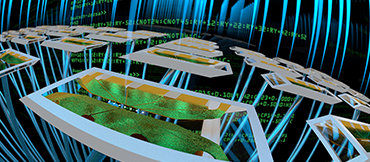Trapped ions and superconductors face off in quantum benchmark
- Details
- Published: Thursday, April 13 2017 10:34
 An artist's rendering of many linked trapped-ion modules. Researchers at JQI put one of their modules to the test against an IBM superconducting device. (Credit: E. Edwards/JQI)
An artist's rendering of many linked trapped-ion modules. Researchers at JQI put one of their modules to the test against an IBM superconducting device. (Credit: E. Edwards/JQI)
The race to build larger and larger quantum computers is heating up, with several technologies competing for a role in future devices. Each potential platform has strengths and weaknesses, but little has been done to directly compare the performance of early prototypes. Now, researchers at the JQI have performed a first-of-its-kind benchmark test of two small quantum computers built from different technologies.
The team, working with JQI Fellow Christopher Monroe and led by postdoctoral researcher Norbert Linke, sized up their own small-scale quantum computer against a device built by IBM. Both machines use five qubits—the fundamental units of information in a quantum computer—and both machines have similar error rates. But while the JQI device relies on chains of trapped atomic ions, IBM Q uses coupled regions of superconducting material.
To make their comparison, the JQI team ran several quantum programs on the devices, each of which solved a simple problem using a series of logic gates to manipulate one or two qubits at a time. Researchers accessed the IBM device using an online interface, which allows anyone to try their hand at programming IBM Q.
Both computers have strengths and weaknesses. For example, the superconducting platform has quicker gates and may be easier to mass produce, but its man-made qubits are all slightly different and have shorter lifetimes. Monroe says that the slower gates of ions might not be a major hurdle, though. "Because there is time," Monroe says. "Trapped ion qubit lifetimes are way longer than any other type of qubit. Moreover, the ion qubits are identical, and they can be better replicated without error."
When put to the test, researchers found that the trapped-ion module was more accurate for programs that involved many pairs of qubits. Linke and Monroe attribute this to the simple fact that every qubit in their device is connected to every other—meaning that a logic gate can connect any pair of qubits. IBM Q has fewer than half the connections of its JQI counterpart, and in order to run some programs it had to shuffle information between qubits—a step that introduced errors into the calculation. When this shuffling wasn't necessary, the two computers had similar performance. "As we build larger systems, connectivity between qubits will become even more important," Monroe says.
The new study, which was recently published in Proceedings of the National Academy of Sciences, provides an important benchmark for researchers studying quantum computing. And such head-to-head comparisons will become increasingly important in the future. "If you want to buy a quantum computer, you'll need to know which one is best for your application," Linke says. "You'll need to test them in some way, and this is the first of this kind of comparison."
By Erin Marshall
REFERENCE PUBLICATION
"Experimental comparison of two quantum computing architectures," N.M. Linke, D. Maslov, M. Roetteler, S. Debnath, C. Figgatt, K.A. Landsman, K. Wright, C. Monroe, Proceedings of the National Academy of Sciences, 114, 3305-3310 (2017)
RESEARCH CONTACT
Norbert Linke|This email address is being protected from spambots. You need JavaScript enabled to view it.
Christopher Monroe|This email address is being protected from spambots. You need JavaScript enabled to view it.
RELATED JQI ARTICLES
Programmable ions set the stage for general-purpose quantum computers
